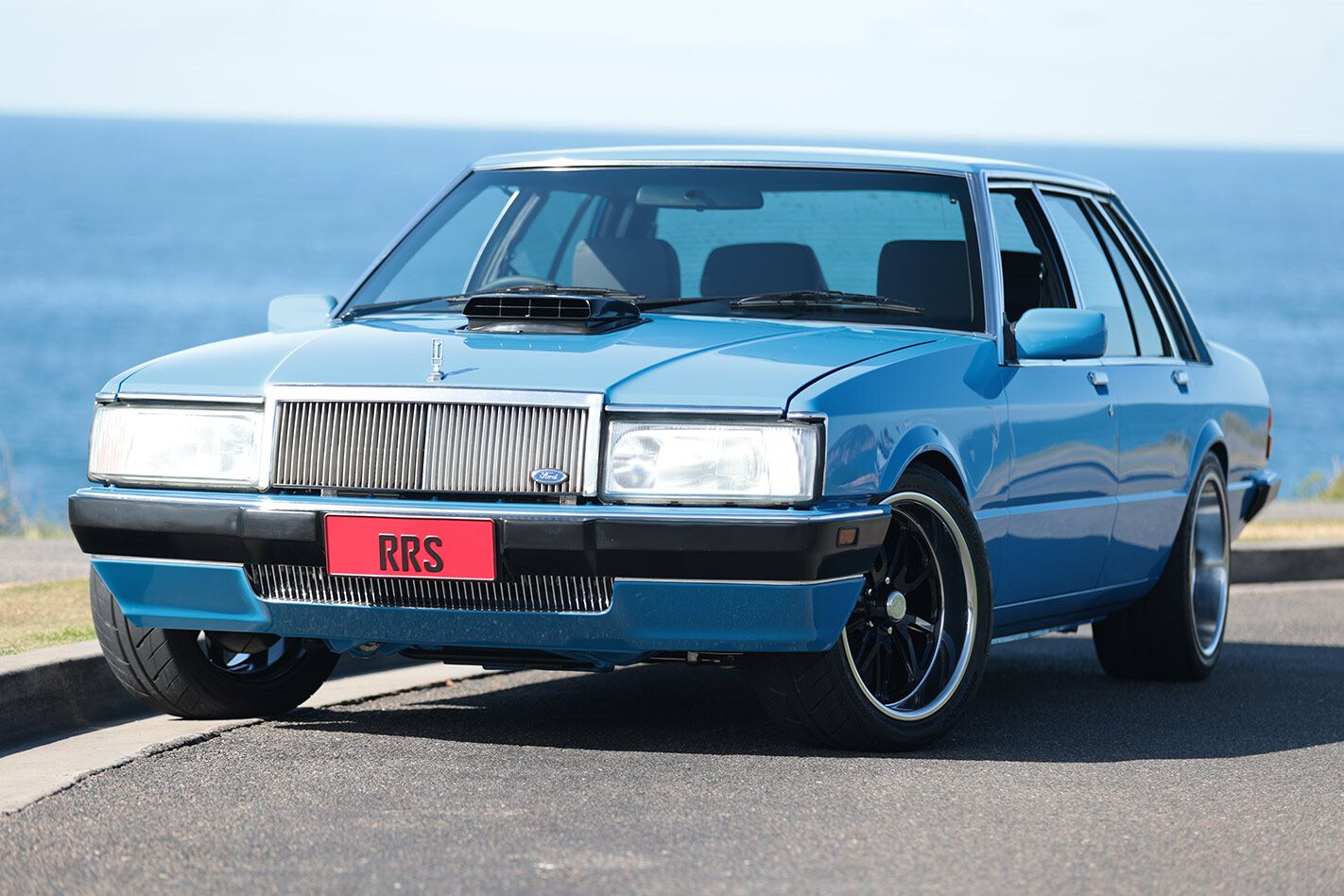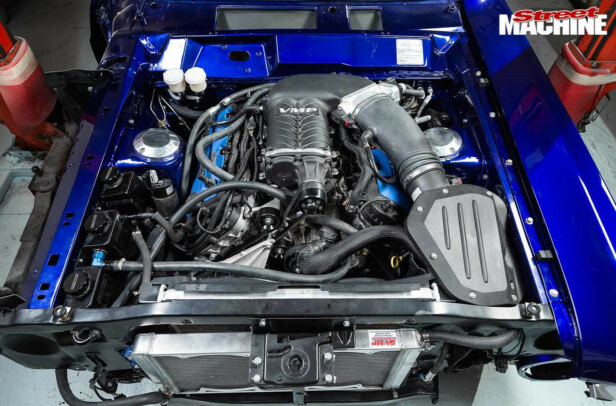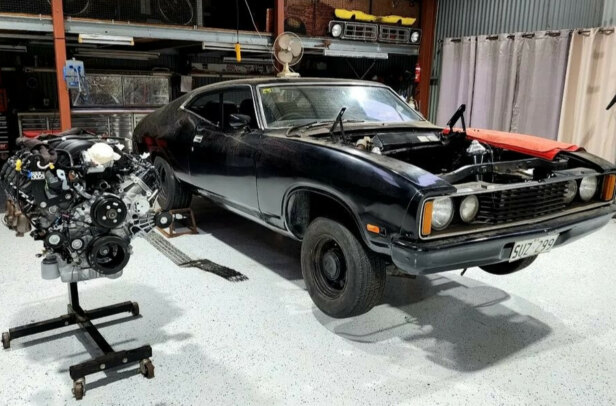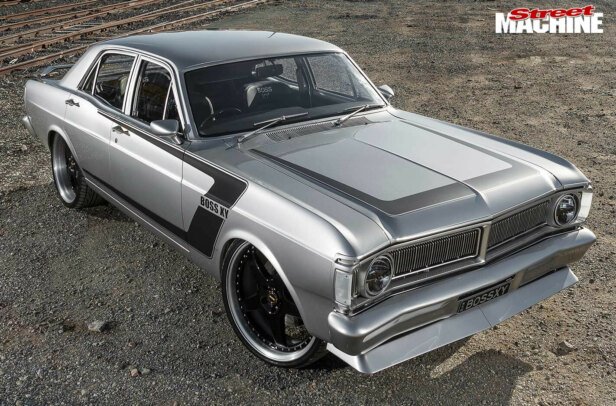RETROTECH: The art of dropping a late-model motor into an old-school chassis. It’s a great way to improve the starting, running, driveability and maintenance of any classic streeter. Better still, it often comes with the added bonus of more power!
This article was first published in the September 2020 issue of Street Machine
Although a little unloved, Ford Australia’s 5.4-litre quad-cam Boss V8 has a tonne of hidden potential. Unfortunately, the difficulty of slotting one into a classic FoMoCo hasn’t helped its popularity. But Sydney-based Ford suspension specialist RRS has come to the rescue. Using its unique strut front suspension system, RRS has developed and completed a number of Boss swaps, and offered to run us through all the ins and outs.
THE ENGINE
A hybrid version of the American ‘Modular’ V8, the 32-valve, 5.4-litre Boss motor is uniquely Australian. It’s incredibly strong (thanks to cross-bolted mains), loves to rev and makes good power past 6000rpm. You’ll find them in XR8, GT and GT-P cars from 2003 through to 2010, when the all-alloy 5.0-litre V8 was introduced. There are four basic versions: Boss 260, 290, 302 and 315. The number of each designates its kW output.
At 780mm, the Aussie Boss is seriously wide – 132mm wider than a Cleveland and 94mm wider than an FE or 460 big-block. In fact, it’s 19mm wider than the famed Boss 429 and 427 Hemi! Surgery is unavoidable, but RRS offers both a solution and an upgrade: a shock tower notching kit (which adds plenty of extra room) and a bolt-in HO strut set-up.
Stepping up to the RRS struts provides plenty of advantages: improved geometry, increased static castor, camber gain, dramatically reduced bump steer and scrub radius, superior shock motion ratio, reduced unsprung weight, adjustable ride height and variable damper rates. Get the idea?
GET OUTTA THE WAY
While the alternator, power steering pump and air-con compressor can all remain on the engine untouched, you’re not so lucky when it comes to the air intake and the vehicle’s brake booster. The Boss’s factory intake points straight into the shock tower, which RRS typically converts to a forward-facing configuration. However, on the 1979 Fairlane you see on these pages, the Yella Terra supercharger raises the intake just enough to allow the angle of the twin throttlebody to be cut and re-welded so that it can hook up to an airbox. And yes, the addition of the supercharger does create bonnet clearance issues, which requires trimming a small amount of bracing.
As for the booster/master cylinder, the Aussie Boss plonks a big-arse rocker cover right where they normally live. But RRS has a bolt-in solution in the form of its Stealth SS under-dash booster kit. Sorted!
With the booster out of the way and the HO struts and tower notching kit in place, bolting the Boss into the bay is relatively straightforward thanks to the RRS engine mounts, sump, gearbox mounts and extractors. The company has taken care of getting it fired up as well, with a range of modified factory ECU and wiring harness combinations available. Anybody who’s worked with Ford’s BA-FG electronics knows that it’s a lot tougher than working with GM hardware.
IN GEAR
Transmission options include the Tremec six-speed manual, four-speed BTR auto and the ZF six-speed auto. However, it’s very important that the engine, gearbox, ECU and harness are all from the same donor car. Autos from BF onwards don’t have a slip yoke; to solve this problem, RRS has engineered tailshaft adapters that incorporate the necessary yoke.
Both the six-speed manual and ZF auto require tunnel mods – mainly sectioning the tunnel and raising it up around one inch, as well as a bit of massaging up at the firewall in the case of the ZF. The ZF also requires the use of the original floor shifter out of the donor car, as it incorporates a load of tricky CAN-bus electronics. Here, RRS makes use of a repro XR-XY Falcon tunnel hump, onto which the ZF shifter is bolted. However, it’s necessary to neatly trim around the entire perimeter of the tunnel hump, rather than just rough-cut a small section in the middle like Ford did on the assembly line back in the day.
SMOOTH RIDE
The 5.4-litre Boss is a torque monster, and will definitely test any classic Ford’s original leaf-spring suspension system. Here again RRS offers a solution and an upgrade with its bolt-in Trans Am three-link. This torque-arm set-up is good for over 1000lb-ft, and RRS states that the long links/arms provide superior arcs of motion over a traditional short-arm four-link. The three-link also offers excellent anti-squat and precise lateral diff location thanks to its Watt’s linkage or Mumford linkage (depending on the vehicle).
COOLING & FUEL
No need to re-invent the wheel here. The factory BA-FG radiator and twin thermo fan set-up does an admirable cooling job – and it drops into most classic Fords with only modest trimming of the radiator support. It also works well with the matching a/c condenser – and you can use factory radiator hoses! A pressurised purge tank plumbed to the two ‘steam ports’ is a must. Without it, the engine will overheat no matter what you do.
RRS can modify most old fuel tanks to accept the BA-FG electric in-tank pump set-up. You’ll just need to fashion your own 10mm, 3/8in or –6 hard lines. On a maximum-effort naturally aspirated or supercharged beast, RRS recommends stepping up to something like a Walbro.
NEW CONVERTS
RRS has developed a number of different Boss conversion kits for a variety of Fords, with several test vehicles racking up plenty of R&D miles. The company also offers everything necessary to complete a Coyote V8 or turbocharged Barra swap as well. Visit rrs-online.com.au or phone (02) 9907 3755 for more info.
UNDER PRESSURE
All the Aussie Boss motors respond exceptionally well to supercharging. Harrop and Yella Terra both offer comprehensive kits. This 1979 Fairlane (with LTD tail-lights and grille) is equipped with the Yella Terra kit, which makes a very handy 385kW (520hp) at the hides – making this machine as spirited to drive as it is eye-catching.
OPEN WIDE
Fitting an Aussie quad-cam Boss under the bonnet is going to require metal surgery – full stop. The RRS notching kit and struts add a tonne of extra width – enough to squeeze a big, bad Boss between the rails of the rather cramped ’60-’66 Falcon (Aussie and US) or ’64-’66 Mustang – all of which are noticeably narrower than subsequent models. Other necessary surgery includes clearancing the firewall/passenger footwell for the starter motor.
WORKING THE ANGLES
One issue the RRS team has discovered when transplanting late-model drivelines into early-girl Fords is the driveline angle. It has to be spot-on; any misalignment dramatically reduces the driveline’s maximum rpm and torque capability. Also, with the ZF gearbox, you need to stick with 2.75 or 2.9:1 diff gears, otherwise first gear is rendered useless – it’ll take off in second!
IN DETAIL:
Despite the hefty girth of the Aussie Boss, it weighs the same as a factory 4V 351 Clevo – so there’s no weight penalty. Match the RRS headers with a free-flowing dual exhaust and the modern Boss will deliver that classic muscle car rumble.
Tower notching kits are key to the swap, but they don’t work with the factory suspension; you’ll have to upgrade to the RRS struts. But there’s a bonus, as the struts bring with them all those modern suspension niceties you’ll find in a late-model Falcon or Mustang.
The recirculating-ball steering box can be retained – but why would you want to? The RRS power-assisted GT rack delivers fewer turns lock-to-lock, near-zero bump steer and improved Ackermann geometry, along with a tight, modern, responsive feel.
Using the RRS engine mounts and sump, the Boss V8 fits under the bonnet of most classic Fords – just. To give it that muscle car look, this Fairlane was fitted with an iconic XY shaker.
Something missing? Yep, the master cylinder and brake booster now live under the dash. Relocation was thanks to the Stealth SS under-dash booster kit from RRS.
More power warrants better braking. RRS upgraded this Fairlane with its Phase 4 kit up front (Cobra four-piston calipers and 330mm rotors) and matching RD3 combo (Cobra four-piston calipers and 315mm rotors) at the rear.
The factory sequential sports shifter looks right at home. The fly-by-wire throttle pedal is also a must, with RSS offering neat brackets to bolt it in place. The RRS wiring harnesses feature outputs to hook up regular gauges, including a cable-drive speedo. They’re not able to hook up the factory BA-FG dash just yet, but the company is working on it.




Comments